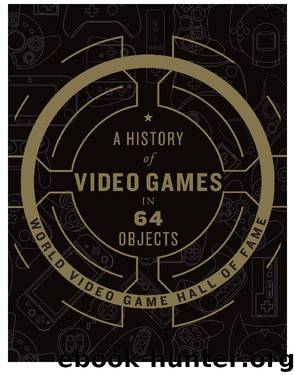A History of Video Games in 64 Objects by world video game hall of fame

Author:world video game hall of fame
Language: eng
Format: epub
Published: 2018-05-29T04:00:00+00:00
Facing reluctant retailers who had little interest in yet another video game console and latching on to a craze for robots in the toy industry, Nintendo devised eye-catching accessories like this R.O.B. (Robotic Operating Buddy) to bundle with the NES.
Nintendo realized it would have to abandon the hybrid approach and release the AVS solely as a video game console, just as it had in Japan. Careful to avoid appearing like just another video game system in a market saturated with clones and derivatives, Nintendo did away with the AVS’s bells and whistles and positioned its console—now called the “Nintendo Entertainment System” (NES)—squarely in the toy market. To distinguish the NES from other consoles, Nintendo called its cartridges “paks,” added a Robotic Operating Buddy (R.O.B.), a light gun “Zapper,” and engineered a front-loading cartridge chamber that kept games hidden from view. (This also made the NES more prone to breakdown, although Nintendo addressed this flaw by building a highly regarded repair network.) Nintendo also continued to ensure that third-party developers could not flood the market with poorly built games by installing a lockout chip that prevented unauthorized games from running on the NES. As Nintendo president Yamauchi later said, “Atari collapsed because they gave too much freedom to third-party developers and the market was swamped with rubbish games.”
Nintendo initiated a limited test launch on October 18, 1985, in the New York City market, releasing the NES with a modest production run of one hundred thousand units alongside a catalog of seventeen games including Duck Hunt, 10-Yard Fight, Baseball, Kung Fu, and Wild Gunman. Nintendo sold most of its stock, and after experimenting with various other test markets, launched the NES nationwide in September 1986, with a multimillion-dollar marketing budget. The console sold more than a million units that year, and Nintendo raked in over $300 million. (By comparison, according to some estimates the entire video game industry only made $100 million in 1985.) Leading the charge was Super Mario Bros., which became available in the U.S. starting in early 1986 and took the American market by storm. (For more about Super Mario Bros.)
The NES rapidly became a mammoth hit, eventually selling some sixty million units during its long and storied production history while immortalizing countless game characters including Mario, Link, and Samus Aran. Why did the NES succeed in such a desolate market? Many credit Nintendo’s strict licensing terms that limited most third-party companies to five yearly releases, with Nintendo controlling all cartridge manufacturing. With game producers having to conform to Nintendo’s standards of quality and their family-friendly image, the company had complete control over distribution and was able to avoid the deluge of poor-quality games that doomed Atari and so many other game companies.
But most important, Nintendo embraced a generous customer service operation by instituting a massive repair network and a free hotline. It also launched the Nintendo Fun Club, a free newsletter that offered tips, tricks, and video game news. The newsletter was later replaced by Nintendo Power magazine, which enjoyed a circulation of nearly four hundred seventy-five thousand at its height.
Download
This site does not store any files on its server. We only index and link to content provided by other sites. Please contact the content providers to delete copyright contents if any and email us, we'll remove relevant links or contents immediately.
| Anthropology | Archaeology |
| Philosophy | Politics & Government |
| Social Sciences | Sociology |
| Women's Studies |
Cecilia; Or, Memoirs of an Heiress — Volume 1 by Fanny Burney(32435)
Cecilia; Or, Memoirs of an Heiress — Volume 2 by Fanny Burney(31871)
Cecilia; Or, Memoirs of an Heiress — Volume 3 by Fanny Burney(31856)
The Great Music City by Andrea Baker(31367)
We're Going to Need More Wine by Gabrielle Union(18969)
All the Missing Girls by Megan Miranda(15579)
Pimp by Iceberg Slim(14396)
Bombshells: Glamour Girls of a Lifetime by Sullivan Steve(13976)
Talking to Strangers by Malcolm Gladwell(13223)
Norse Mythology by Gaiman Neil(13209)
Fifty Shades Freed by E L James(13157)
For the Love of Europe by Rick Steves(13032)
Mindhunter: Inside the FBI's Elite Serial Crime Unit by John E. Douglas & Mark Olshaker(9204)
Crazy Rich Asians by Kevin Kwan(9168)
The Lost Art of Listening by Michael P. Nichols(7409)
Enlightenment Now: The Case for Reason, Science, Humanism, and Progress by Steven Pinker(7237)
The Four Agreements by Don Miguel Ruiz(6635)
Bad Blood by John Carreyrou(6552)
Weapons of Math Destruction by Cathy O'Neil(6147)
